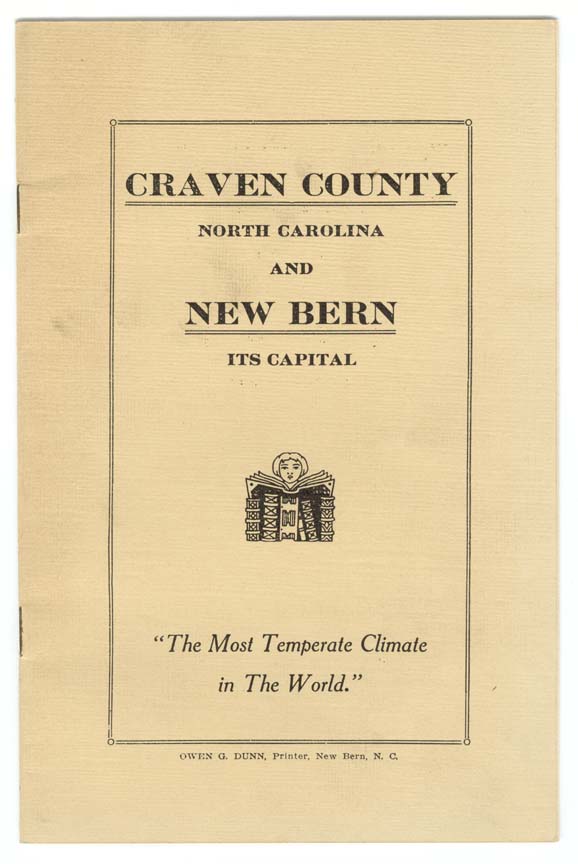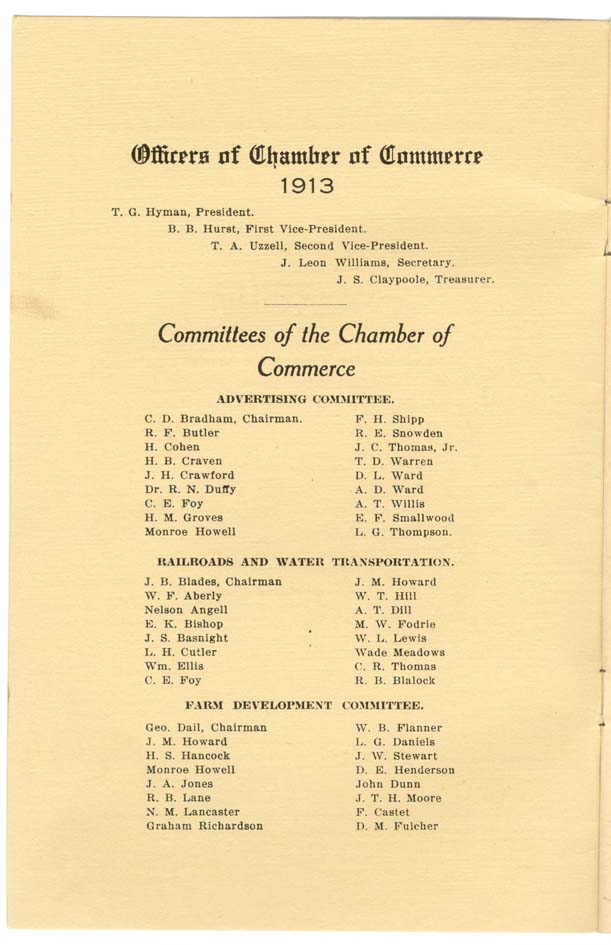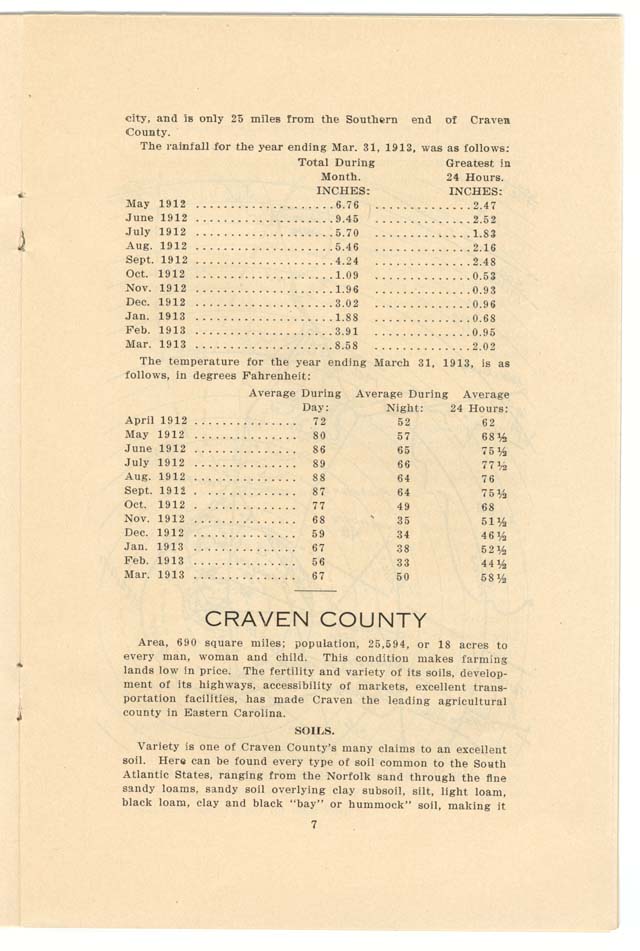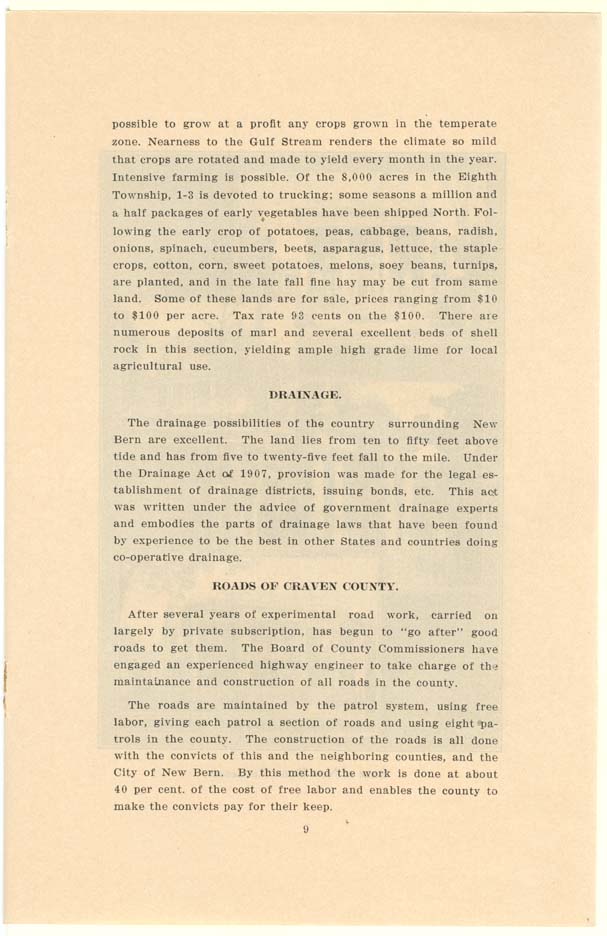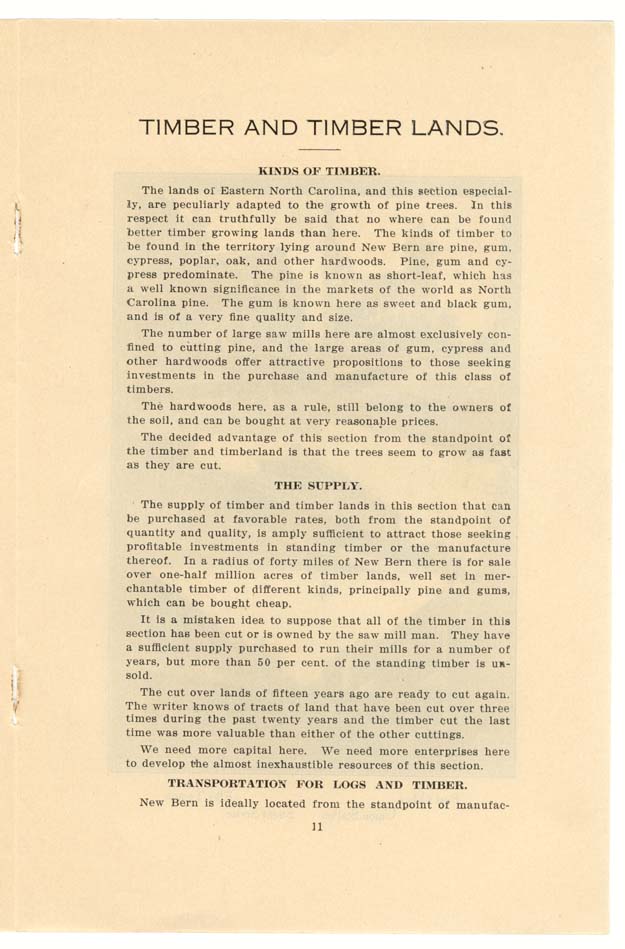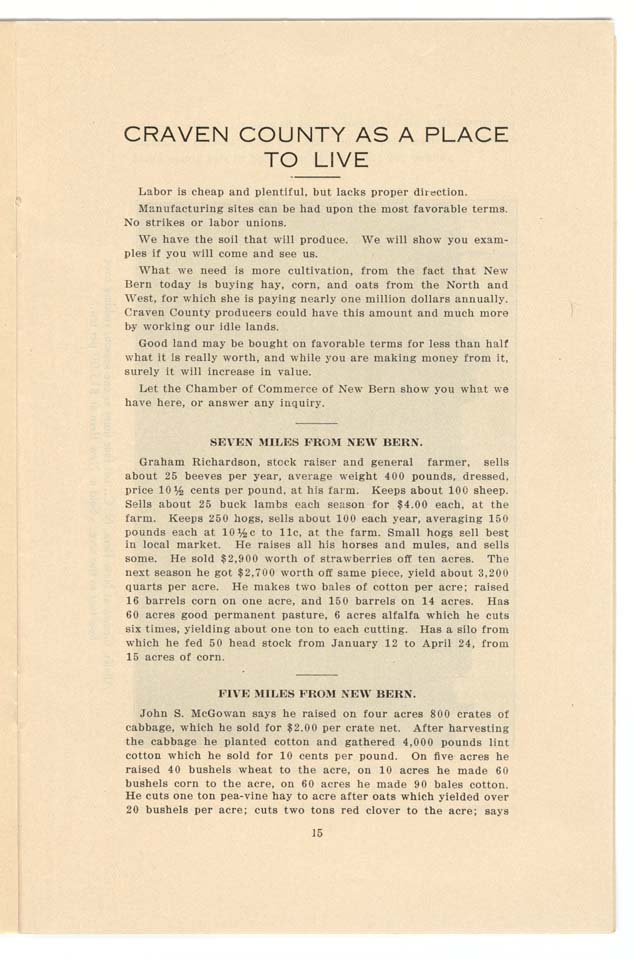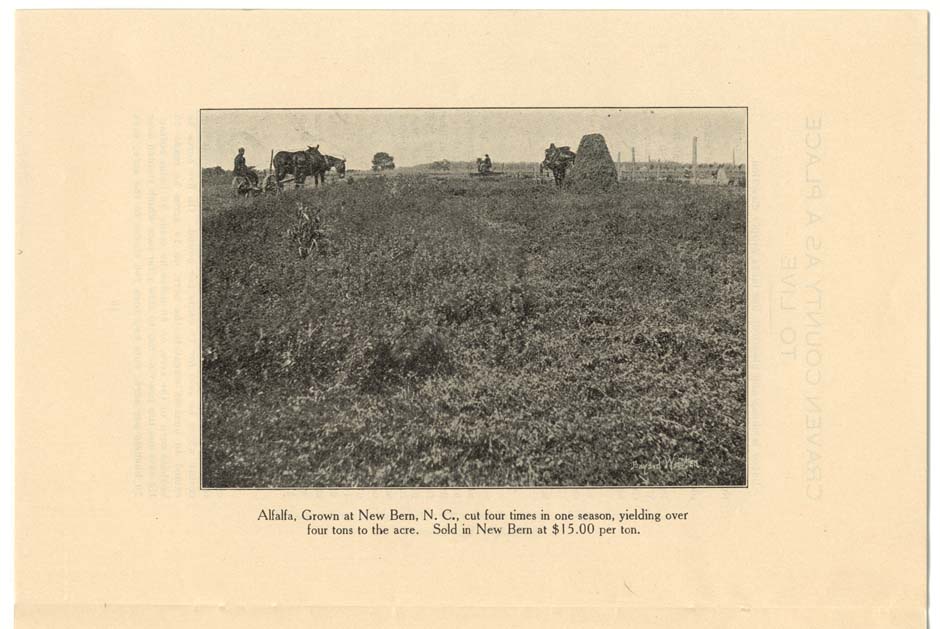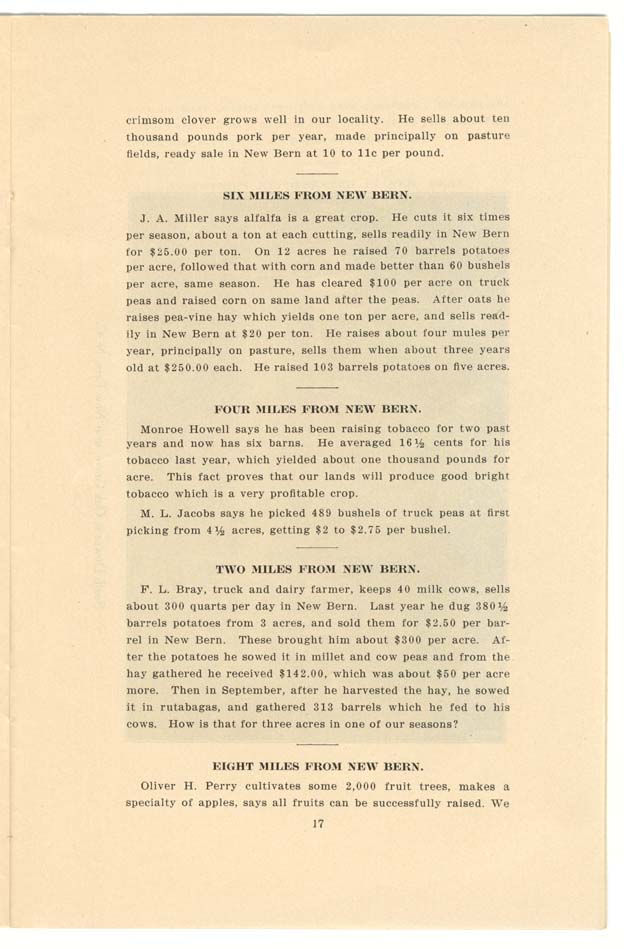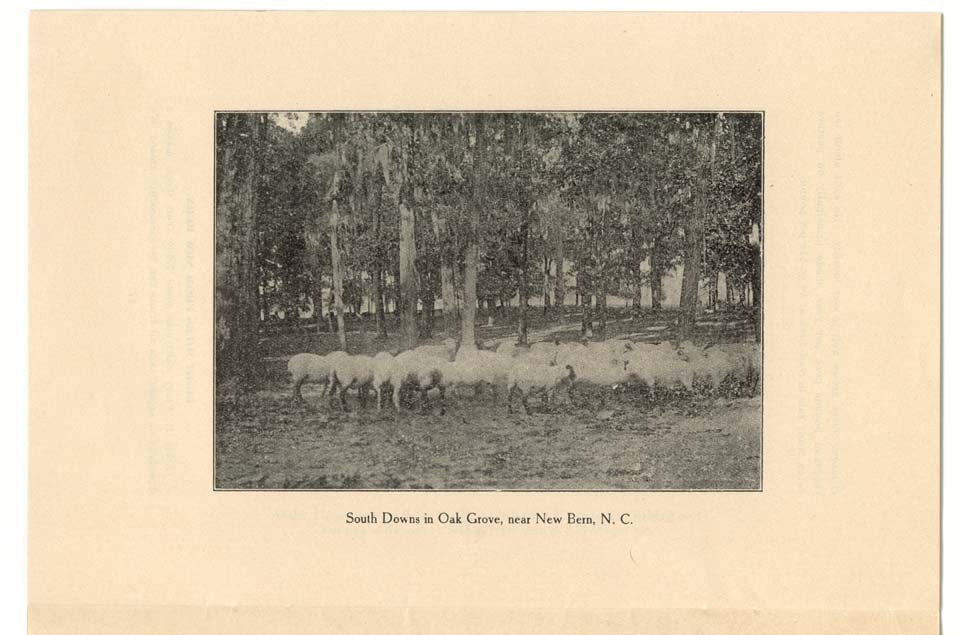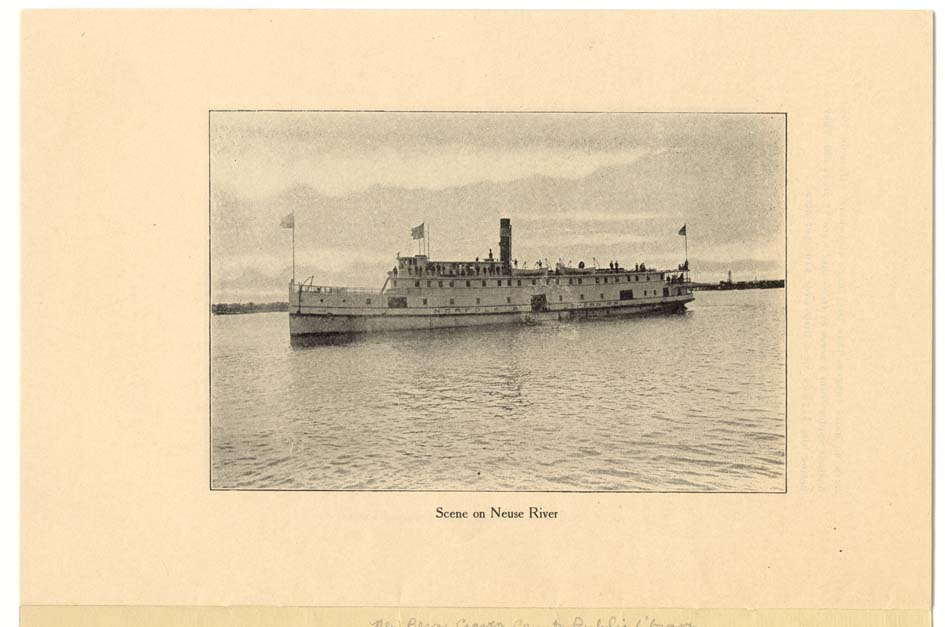
Craven County, North Carolina and
New Bern It's Capital (1913)
Bibliographic information:
New Bern Chamber of Commerce. Craven County, North Carolina and New
Bern It's Capital: "The Most Temperate Climate in the World." (New Bern,
N.C.: Owen G. Dunn, 1913), 20 p. This document is an early Chamber of Commerce
booklet to entice investors and "home seekers" to locate in New Bern and Craven
County.
[Click on an image to enlarge that image.]
[front cover]
CRAVEN COUNTY
NORTH CAROLINA
AND
NEW BERN
ITS CAPITAL
“The Most Temperate Climate in The World.”
OWEN G. DUNN, Printer, New Bern, N. C.
[inside front cover]
Officers of Chamber of Commerce
1913
T.G. Hyman, President.
B.B. Hurst, First Vice-President.
T.A. Uzzell, Second Vice-President.
J. Leon Williams, Secretary.
J.S. Claypoole, Treasurer.
Committees of the Chamber of Commerce
ADVERTISING COMMITTEE.
C.D. Bradham, Chairman.
F.H. Shipp
R.F. Butler
R.E. Snowden
H. Cohen
J.C. Thomas, Jr.
H.B. Craven
T.D. Warren
J.H. Crawford
D.L. Ward
Dr. R.N. Duffy
A.D. Ward
C.E. Foy
A.T. Willis
H.M. Groves
E.F. Smallwood
Monroe Howell
L.G. Thompson.
RAILROADS AND WATER TRANSPORTATION.
J.B. Blades, Chairman
W.F. Aberly
Nelson Angell
E.K. Bishop
J.S. Basnight
L.H. Cutler
Wm. Ellis
C.E. Foy
J.M. Howard
W.T. Hill
A.T. Dill
M.W. Fodrie
W.L. Lewis
Wade Meadows
C.R. Thomas
H.B. Blalock
FARM DEVELOPMENT COMMITTEE.
Geo. Dail, Chairman
J.M. Howard
H.S. Hancock
Monroe Howell
J.A. Jones
R.B. Lane
N.M. Lancaster
Graham Richardson
W.B. Flanner
L.G. Daniels
J.W. Stewart
D.E. Henderson
John Dunn
J.T. H. Moore
F. Castet
D.M. Fulcher
[p. 1]
FOREWORD.
THE PURPOSE of this booklet is to open the minds of investors and home-seekers to agricultural conditions in Craven County, North Carolina, and the advantages offered at New Bern, its county seat.
Persons desiring to escape the rigors of a cold climate, where farming is restricted, or where price of land is prohibitive, are invited to investigate conditions. Manufacturers in need of sites, good transportation facilities, and an abundance of raw material, will be furnished full information by applying to:
CHAMBER OF COMMERCE, or The Advertising Committee.
New Bern, N. C., May 1, 1913.
[p. 2]
Public Schools
Water Front
Lumber Mill
Court House
[p. 3]
REASONS WHY NEW BERN SHOULD BE SELECTED BY:
A. MANUFACTURERS, C. FARMERS,
B. MERCHANTS,
D. HOMERS.
A.1. Transportation facilities,
2. Material at hand,
3. Labor,
4. Climate,
5. Location.
B. 1. Market,
2. Growing population.
3. Rents low,
4. Opportunity.
C. 1. Climate,
2. Soil productiveness, fertility,
3. Labor,
4. Market.
D.1. Climate,
2. Health statistics,
3. Schools,
4. Churches,
5. Rents low,
6. Lots cheap, and lumber,
7. Markets good, Cheap—Fish, Vegetables, Poultry, Game, Dairy Products.
Bee Raising, Sash and Blinds, Hardwood Specialties.
Taxable value of property in Craven County…$12,000,000.00
Rate of Taxation, 1912, (including Special School and Road Levies)…83 2-3
TRANSPORTATION:
Norfolk Southern Railway to Norfolk.
Norfolk Southern Railway to Goldsboro, 59 miles.
Norfolk Southern Railway to Beaufort, Harbor of Refuge, 36 miles.
Atlantic Coast Line Railway to Wilmington, 84 miles.
Atlantic Coast Line Railway to Norfolk and Richmond, Va., (Connection
Building).
CHURCHES:
Episcopal…3
Catholic…2
Presbyterian…1
Disciple…1
Methodist…2
Christian Science…1
Baptist…2
Free Will Baptist…1
[p. 4]
Railroad and Water Advantages of New Bern
[p. 5]
“Athens of North Carolina”
NEW BERN, long known as the “Athens of North Carolina,” has an excellent system of Graded Schools with modern equipment. The County School System has about 90 schools, including the State High Schools at Dover and Vanceboro.
At Vanceboro is located the only “State” Farm Life School. This school will be opened in the Fall of 1913 with new buildings and equipment costing about $25,000, in addition to 80 acres of land.
Churches of almost every denomination are to be found throughout Craven County and in New Bern some of the finest Church buildings are to be found—among these are Centenary Methodist, the Presbyterian, the Episcopal, the Baptist, the Christian and Catholic Churches.
The Fraternal spirit of New Bern is well shown in the flourishing lodges represented here. The Elks have on the corner of Middle and Pollock streets a five-story building, the entire fifth floor of which is magnificently fitted up as a lodge room. The Masonic Fraternity, the Woodmen, the Odd Fellows, the Knights of Pythias, the Red Men, the Royal Arcanum, and others, all have large branches here and much fine work is done by the membership of these orders.
The population of New Bern is increasing rapidly. New houses are going up continually, but few empty houses are to be found at any time. The population of the County as given by the census of 1910 is 25,594; and of New Bern, 9,961. The increase since 1910 has been large, especially in and about New Bern. Rate of taxation, $1.05.
HEALTH.
The health of the City of New Bern is above the average. The average number of deaths per thousand people, throughout the United States, is: whites 16, colored 26.4. This would give the City of New Bern an average for the whites and blacks, 21.2. From the registered deaths occurring in the City of New Bern we find that the average for the white and black combined is only 18.4 out of every thousand. The progress made in sewerage and drainage is fast reducing the above creditable average.
CLIMATE.
The climate of this section is unusually mild, owing to the proximity of the Gulf Stream, which is only 57 miles from the
[p. 6]
Some of New Bern’s Churches
[p. 7]
city, and is only 25 miles from the Southern end of Craven County.
The rainfall for the year ending Mar. 31, 1913, was as follows:
Total During
Greatest in
Month 24 Hours.
INCHES: INCHES:
May 1912…6.76…2.47
June 1912…9.45…2.52
July 1912…5.70…1.83
Aug. 1912…5.46…2.16
Sept. 1912…4.24…2.48
Oct. 1912…1.09…0.53
Nov. 1912…1.96…0.93
Dec. 1912…3.02…0.96
Jan. 1913…1.88…0.68
Feb. 1913…3.91…0.95
Mar. 1913…8.58…2.02
The temperature for the year ending March 31, 1913, is as follows, in degrees Fahrenheit:
Average During Average During Average
Day: Night: 24 Hours:
April 1912…72…52…62
May 1912…80…57…68-1/2
June 1912…86…65…75-1/2
July 1912…89…66…77-1/2
Aug. 1912…88…64…76
Sept. 1912…87…64…75-1/2
Oct. 1912…77…49…68
Nov. 1912…68…35…51-1/2
Dec. 1912…59…34…46-1/2
Jan. 1913…67…38…52-1/2
Feb. 1913…56…33…44-1/2
Mar. 1913…67…50…58-1/2
CRAVEN COUNTY
Area, 690 square miles; population, 25,594, or 18 acres to every man, woman
and child. This condition makes farming lands low in price. The fertility
and variety of its soils, development of its highways, accessibility of
markets, excellent transportation facilities, has made Craven the leading
agricultural county in Eastern Carolina.
SOILS.
Variety is one of Craven County’s many claims to an excellent soil. Here can
be found every type of soil common to the South Atlantic States, ranging
from the Norfolk sand through the fine sandy loams, sandy soil overlying
clay subsoil, silt, light loam, black loam, clay and black “bay” or hummock”
soil, making it
[p. 8]
Map Showing Distance of Important Cities From New Bern
[p. 9]
possible to grow at a profit any crops grown in the temperate zone. Nearness to the Gulf Stream renders the climate so mild that crops are rotated and made to yield every month in the year. Intensive farming is possible. Of the 8,000 acres in the Eighth Township, 1-3 is devoted to trucking; some seasons a million and a half packages of early vegetables have been shipped North. Following the early crop of potatoes, peas, cabbage, beans, radish, onions, spinach, cucumbers, beets, asparagus, lettuce, the staple crops, cotton, corn, sweet potatoes, melons, soey beans, turnips, are planted, and in the late fall fine hay may be cut from same land. Some of these lands are for sale, prices ranging from $10 to $100 per acre. Tax rate 93 cents on the $100. There are numerous deposits of marl and several excellent beds of shell rock in this section, yielding ample high grade lime for local agricultural use.
DRAINAGE.
The drainage possibilities of the country surrounding New Bern are
excellent. The land lies from ten to fifty feet above tide and has from five
to twenty-five feet fall to the mile. Under the Drainage Act of 1907,
provision was made for the legal establishment of drainage districts,
issuing bonds, etc. This act was written under the advice of government
drainage experts and embodies the parts of drainage laws that have been
found by experience to be the best in other States and countries doing
co-operative drainage.
ROADS OF CRAVEN COUNTY.
After several years of experimental road work, carried on largely by private
subscription, has begun to “go after” good roads to get them. The Board of
County Commissioners have engaged an experienced highway engineer to take
charge of the maintainance and construction of
all roads in the county.
The roads are maintained by the patrol system, using free labor, giving each patrol a section of roads and using eight patrols in the county. The construction of the roads is all done with the convicts of this and the neighboring counties, and the City of New Bern. By this method the work is done at about 40 per cent. of the cost of free labor and enables the county to make the convicts pay for their keep.
[p. 10]
Some of New Bern’s Residences
[p. 11]
TIMBER AND TIMBER LANDS.
-----
KINDS OF TIMBER
The lands of Eastern North Carolina, and this section especially, are
peculiarly adapted to the growth of pine trees. In this respect it can
truthfully be said that no where can be found better timber growing lands
than here. The kinds of timber to be found in the territory lying around New
Bern are pine, gum, cypress, poplar, oak, and other hardwoods. Pine, gum and
cypress predominate. The pine is known as short-leaf, which has a well
known significance in the markets of the world as North Carolina pine. The
gum is known here as sweet and black gum, and is of a very fine quality and
size.
The number of large saw mills here are almost exclusively confined to cutting pine, and the large areas of gum, cypress and other hardwoods offer attractive propositions to those seeking investments in the purchase and manufacture of this class of timbers.
The hardwoods here, as a rule, still belong to the owners of the soil, and can be bought at very reasonable prices.
The decided advantage of this section from the standpoint of the timber and timberland is that the trees seem to grow as fast as they are cut.
THE SUPPLY.
The supply of timber and timber lands in this section that can be purchased
at favorable rates, both from the standpoint of quantity and quality, is
amply sufficient to attract those seeking profitable investments in standing
timber or the manufacture thereof. In a radius of forty miles of New Bern
there is for sale over one-half million acres of timber lands, well set in
merchantable timber of different kinds, principally pine and gums, which
can be bought cheap.
It is a mistaken idea to suppose that all of the timber in this section has been cut or is owned by the saw mill man. They have a sufficient supply purchased to run their mills for a number of years, but more than 50 per cent. of the standing timber is unsold.
The cut over lands of fifteen years ago are ready to cut again. The writer knows of tracts of land that have been cut over three times during the past twenty years and the timber cut the last time was more valuable than either of the other cuttings.
We need more capital here. We need more enterprises here to develop the almost inexhaustible resources of this section.
TRANSPORTATION FOR LOGS AND TIMBER.
New Bern is ideally located from the standpoint of manufacturers
[p. 12]
Post Office
Elks Temple
Union Station
Street Scene
[p. 13]
of lumber. The railroad and water transportation for logs for the mill and lumber for the market is satisfactory, ample and cheap.
Situated as it is at the confluence of Neuse and Treat Rivers, both navigable streams, near the great Inland Waterway, to which the United States Government is committed, and which is now in process of construction, about 30 miles from the sea, and about the same distance from Cape Look Out--one of the finest harbors on the coast, and which is now being improved by the United States Government, an appropriation of nearly $2,000,000 having already been made by Congress, their advantages in addition to others heretofore mentioned, should commend themselves to the minds of those seeking profitable investments.
From New Bern the Norfolk Southern Railroad Company operate a direct line to Norfolk, connects with Atlantic Coast Line at Kinston and Goldsboro. A regular line of boats and barges carrying lumber operates from New Bern to Norfolk, Baltimore. Philadelphia, New York, and other Northern markets.
For the purpose of logging, the mills, most of the timber in this section is in easy access of navigable water or railroad facilities. The Norfolk Southern Railroad Company operate trains from here to Morehead City and Beaufort, to Kinston and Goldsboro, to Washington, N. C., Wilson, Raleigh, and Norfolk, to Bayboro and Oriental. The Atlantic Coast Line Railroad Company operate trains from here to Wilmington, N. C., passing through Pollocksville, Maysville, Jacksonville, and other points.
Neuse and Trent Rivers and their tributaries are navigable waters and afford splendid facilities for logging mills.
RATES OF TRANSPORTATION.
The rates for transportation of timber and lumber are very attractive and
moderate. Rates on timber by railroad, per 100 pounds, are as follows:
To Norfolk…8 Cents.
To Baltimore…15 Cents.
To Philadelphia…16 Cents.
To Washington, D. C…14-1/2 Cents.
To New York…20 Cents.
To Boston, Mass….23 Cents.
To Providence, R. I….23 Cents.
To Richmond…9 Cents.
The rates by water on boats or barges are much cheaper, being about one-third less. Everything considered, New Bern and this section of North Carolina offer almost unparalleled opportunities to those who would engage in the manufacture of lumber or in the utilization of the products of the same.
THOS. D. WARREN, Attorney-at-Law,
Chairman Board of Education, Craven County, Ex-State Senator.
Offices 405-406 Elks Building, New Bern, N.C.
[p. 14]
Harvesting Oats in June that were sowed in January, at New Bern, N. C. Farm of J. S. McGowan
[p. 15]
CRAVEN COUNTY AS A PLACE TO LIVE
Labor is cheap and plentiful, but lacks proper direction.
Manufacturing sites can be had upon the most favorable terms. No strikes or labor unions.
We have the soil that will produce. We will show you examples if you will come and see us.
What we need is more cultivation, from the fact that New Bern today is buying hay, corn, and oats from the North and West, for which she is paying nearly one million dollars annually. Craven County producers could have this amount and much more by working our idle lands.
Good land may be bought on favorable terms for less than half what it is really worth, and while you are making money from it, surely it will increase in value.
Let the Chamber of Commerce of New Bern show you what we have here, or answer any inquiry.
-----
SEVEN MILES FROM NEW BERN.
Graham Richardson, stock raiser and general farmer, sells about 25 beeves
per year, average weight 400 pounds, dressed, price 10-1/2 cents per pound,
at his farm. Keeps about 100 sheep. Sells about 25 buck lambs each season
for $4.00 each, at the farm. Keeps 250 hogs, sells about 100 each year,
averaging 150 pounds each at 10-1/2c to 11c, at the farm. Small hogs sell
best in local market. He raises all his horses and mules, and sells some. He
sold $2,900 worth of strawberries off ten acres. The next season he got
$2,700 worth off same piece, yield about 3,200 quarts per acre. He makes two
bales of cotton per acre; raised 16 barrels corn on one acre, and 150
barrels on 14 acres. Has 60 acres good permanent pasture, 6 acres alfalfa
which he cuts six times, yielding about one ton to each cutting. Has a silo
from which he fed 50 head stock from January 12 to April 24, from 15 acres
of corn.
-----
FIVE MILES FROM NEW BERN.
John S. McGowan says he raised on four acres 800 crates of cabbage, which he
sold for $2.00 per crate net. After harvesting the cabbage he planted cotton
and gathered 4,000 pounds lint cotton which he sold for 10 cents per pound.
On five acres he raised 40 bushels wheat to the acre, on 10 acres he made 60
bushels corn to the acre, on 60 acres he made 90 bales cotton. He cuts one
ton pea-vine hay to acre after oats which yielded over 20 bushels per acre;
cuts two tons red clover to the acre; says
[p. 16]
Alfalfa, Grown at New Bern, N.C., cut four times in one season, yielding over four tons to the acre. Sold in New Bern at $15.00 per ton.
[p. 17]
crimsom clover grows well in our locality. He sells about ten thousand pounds pork per year, made principally on pasture fields, ready sale in New Bern at 10 to 11c per pound.
-----
SIX MILES FROM NEW BERN.
J.A. Miller says alfalfa is a great crop. He cuts it six times per season,
about a ton at each cutting, sells readily in New Bern for $25.00 per ton.
On 12 acres he raised 70 barrels potatoes per acre, followed that with corn
and made better than 60 bushels per acre, same season. He has cleared $100
per acre on truck peas and raised corn on same land after the peas. After
oats he raises pea-vine hay which yields one ton per acre, and sells
readily in New Bern at $20 per ton. He raises about four mules per year,
principally on pasture, sells them when about three years old at $250.00
each. He raised 103 barrels potatoes on five acres.
-----
FOUR MILES FROM NEW BERN.
Monroe Howell says he has been raising tobacco for two past years and now
has six barns. He averaged 16-1/2 cents for his tobacco last year, which
yielded about one thousand pounds for acre. This fact proves that our lands
will produce good bright tobacco which is a very profitable crop.
M.L. Jacobs says he picked 489 bushels of truck peas at first picking from 4-1/2 acres, getting $2 to $2.75 per bushel.
-----
TWO MILES FROM NEW BERN.
F.L. Bray, truck and dairy farmer, keeps 40 milk cows, sells about 300
quarts per day in New Bern. Last year he dug 380-1/2 barrels potatoes from 3
acres, and sold them for $2.50 per barrel in New Bern. These brought him
about $300 per acre. After the potatoes he sowed it in millet and cow peas
and from the hay gathered he received $142.00, which was about $50 per acre
more. Then in September, after he harvested the hay, he sowed it in
rutabagas, and gathered 313 barrels which he fed to his cows. How is that
for three acres in one of our seasons?
-----
EIGHT MILES FROM NEW BERN.
Oliver H. Perry cultivates some 2,000 fruit trees, makes a specialty of
apples, says all fruits can be successfully raised. We
[p. 18]
South Downs in Oak Grove, near New Bern, N. C.
[p. 19]
have no more fungess than they have elsewhere. He sold 700 bushels apples from 5 acres of trees that were 12 years old. They netted him $720.00, or a little over $100 per acre.
-----
INDUSTRIES REPRESENTED IN NEW BERN.
John L. Roper Lumber Company.
New Bern Lumber Company.
Blades Lumber Company.
E.H. & J.A. Meadows, Fertilizers.
Virginia-Carolina Chemical Company, Fertilizers.
New Bern Box Factory.
Pepsi-Cola Company, Fountain and Bottlers’ Syrup.
New Bern Cotton Seed Oil and Fertilizer Company.
Owen G. Dunn, Printing and Binding.
Richardson Printing Company, Printing and Binding.
New Bern Sun, Daily.
New Bern Journal, Daily.
Chemical Lime Company, Agricultural Lime.
[p. 20]
Scene on Neuse River.
[Inside Back Cover]
[Outside Back Cover]
Return to Craven County Digital History Exhibit
Images scanned by Dean Knight.
Text prepared by Victor T. Jones, Jr.
This page last edited on June 9, 2015.
